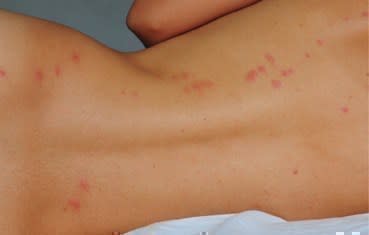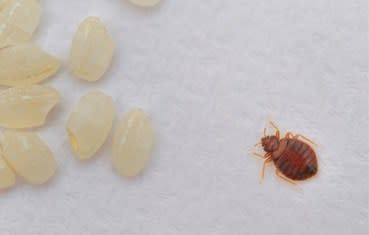Bedbugs: Diagnosis and treatment
How do you know if you have bedbugs?
To find out if you have bedbugs, you need to look for two things:
Bites on your body
Signs of bedbugs
Bites on your body: If you have bedbugs, you’re likely to have bites. Bedbug bites usually cause itchy welts. These welts usually appear in a zigzag pattern as show in the photo below.
Bedbug bites
When bedbugs bite, you often see clusters of bites. Each cluster usually contains 3 to 5 bites that appear in a zigzag pattern.

You’ll seldom see bedbugs, so many people mistakenly believe that mosquitoes, fleas, or spiders bit them. Sometimes people mistake bedbug bites for a common skin condition such as an itchy rash, hives, or chickenpox.
To make sure you have bedbugs, you’ll need to look for signs of bedbugs.
How to check for bedbugs
Although bedbugs don’t usually require serious medical attention, they can cause a great deal of anxiety and restless nights. To find bedbugs before they find you (and your belongings), dermatologists recommend looking for the following signs near places where you sleep.
Signs of bedbugs: This step is important. If you have a bedbug infestation, you need to find out so that you can get rid of the bedbugs. Getting rid of the bedbugs is the only way to stop the bites.
If you have a large number of bedbugs, you may see the bugs. Most people, however, only see signs of bedbugs. To look for signs of bedbugs, check the places that people sleep for the following:
A sweet, musty odor. Take a deep breath. If you notice a sweet, musty in your hotel room, cruise-ship cabin, or other sleeping area, there may be a heavy bedbug infestation in the room. Bedbugs produce chemicals to help them communicate, although not everyone will notice the smell.
Specks of blood on bedding, mattresses, or upholstered furniture such as couches and headboards. Look carefully at your blankets, sheets, and mattress pads and then check the mattress and box spring. Are there specks of blood anywhere, especially near the seams? If so, there could be a bedbug infestation. You should also check for specks of blood on all upholstered furniture, including couches and headboards.
Exoskeletons. Bedbugs have an outer shell that they shed and leave behind. Do you see shell-like remains on the mattress, mattress pad, or beneath couch cushions?
Tiny, blackish specks. If you see blackish specks on the bedding, mattress, headboard, or beneath couch cushions, it could be bedbug excrement.
Eggs. After mating, female bedbugs lay white, oval eggs in cracks and crevices. Keep in mind that these will be small, as a bedbug is only about the size of an apple seed. The photo below shows a bedbug near eggs. The photo was magnified so that you can see the bedbug and eggs.
If you do get bedbugs and have many bites or a bite that looks infected, see a board-certified dermatologist. A dermatologist can treat an infection and help relieve the itch.
Bedbug with eggs
A bedbug is a tiny insect with a broad, oval body. If it has recently eaten, it has a reddish-brown color.

If you see bedbugs, they will likely scurry toward the closest hiding place. Any dark place such as inside a mattress or even a picture frame makes a good hiding place.
As you watch bedbugs move, it can look like they are flying or jumping because they can crawl quickly. Bedbugs cannot fly or jump; they can only crawl.
If you find signs of bedbugs, call a pest-control company or your property manager. You should not use bug spray or a fogger. These products have little effect on bedbugs.
Treating bedbug bites
You should see a dermatologist for treatment if you have:
Many bites
Blisters
Skin infection (bites feel tender or ooze discharge, such as pus)
An allergic skin reaction (skin red and swollen or hives)
Your dermatologist may prescribe medication to treat the following:
Allergic reaction. Some people may require an injection of an antihistamine, corticosteroid, or epinephrine (adrenaline) for a severe allergic reaction.
Infection. An infection may require an antibiotic. If the infection is mild, your dermatologist may recommend an antiseptic medication that you can buy without a prescription. Your dermatologist will tell you which one to use. Your dermatologist also may recommend an antiseptic to prevent a skin infection.
Itch. A prescription antihistamine pill or liquid can help. You also can apply a corticosteroid to the bites. Your dermatologist will tell you which is best for you.
At-home treatment
If you do not have any signs of an infection or a serious reaction, you can often treat the bites at home.
To treat bedbug bites:
Wash the bites with soap and water. This will help prevent a skin infection and help reduce itchiness.
If the bites itch, apply a corticosteroid cream to the bites. You can get a weak form of this medicine without a prescription at your local drugstore. Stronger corticosteroids require a prescription.
Bedbug bites usually heal and go away within a week or two.
Image
Getty Images
References
Leverkus M et al. “Bullous Allergic Hypersensitivity to Bed bug Bites Mediated by IgE against Salivary Nitrophorin." J of Invest Dermatol. 2006;126:2364-2366.
Liebold K et al. “Disseminated bullous eruption with systemic reaction caused by Cimex lectularius.” J Euro Acad of Dermat and Vener. 2003;17:461-463.
Steen CJ, Carbonaro PA, Schwartz RA. “Arthropods in dermatology.” J Am Acad Dermatol 2004; 50:819-42.
 Atopic dermatitis: More FDA-approved treatments
Atopic dermatitis: More FDA-approved treatments
 Biosimilars: 14 FAQs
Biosimilars: 14 FAQs
 How to trim your nails
How to trim your nails
 Relieve uncontrollably itchy skin
Relieve uncontrollably itchy skin
 Fade dark spots
Fade dark spots
 Untreatable razor bumps or acne?
Untreatable razor bumps or acne?
 Tattoo removal
Tattoo removal
 Scar treatment
Scar treatment
 Free materials to help raise skin cancer awareness
Free materials to help raise skin cancer awareness
 Dermatologist-approved lesson plans, activities you can use
Dermatologist-approved lesson plans, activities you can use
 Find a Dermatologist
Find a Dermatologist
 What is a dermatologist?
What is a dermatologist?